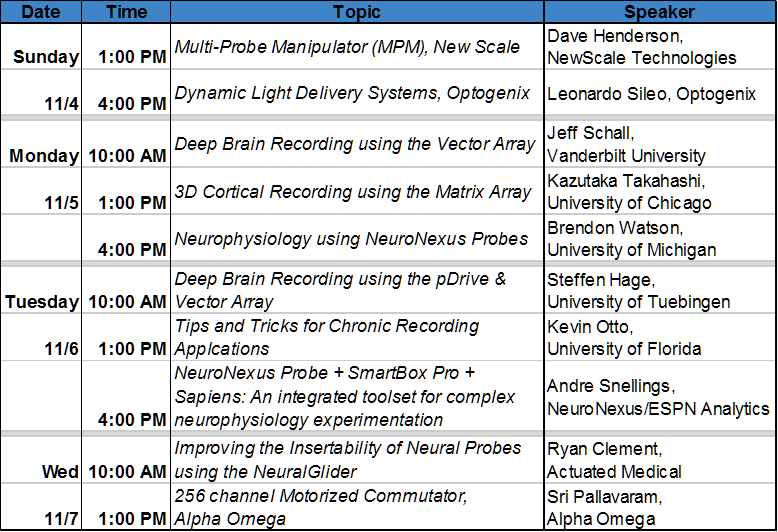| neuronexus.com |
| Register now for our SfN 2018 workshops!
NeuroNexus will hold a series of 30 minute workshops to demonstrate some of our products. Seating is limited, first 10 registrants for each workshop get NeuroNexus swag! All workshops will be held at the NeuroNexus booth (1113).
Sunday, November 4th
1:00 PM Multi-Probe Manipulator (MPM), New Scale
Speaker: David Henderson (CEO of NewScale)
Mr. Henderson will demo the Multi-Probe Manipulator (MPM) system with precise motorized positioning of multiple NeuroNexus probes. This will be accomplished through a single computer interface and joystick control. The demo will also feature the all-new capability to pre-target each probe within the mouse brain using NewScale’s integrated Virtual Coordinate System (VCS) software.
4:00 PM Dynamic Light Delivery Systems, Optogenix
Speaker: Leonardo Sileo (CEO, Optogenix)
Mr. Sileo will present on the new optical fiber technology that Optogenix has pioneered. Optogenix has developed innovative technologies that provide unique approaches to light delivery in support of optogenetics research. These technologies allow for uniform large-volume illumination and spatially addressable multi-point light delivery with extremely thin and sharp optical fibers.
Monday, November 5th
10:00 AM Deep Brain Recording using the Vector Array
Speaker: Jeffrey Schall, PhD (Professor of Neuroscience, Vanderbilt University)
Dr. Schall is an experienced neurophysiologist who uses the NeuroNexus Vector array as a tool for accessing specific brain structures to record neural spikes and field potentials. Dr. Schall will talk through his experience of using the Vector Array, which allows for precise targeting of deep brain structures for recording and/or stimulation applications.
1:00 PM 3D Cortical Recording using the Matrix Array
Speaker: Kazutaka Takahashi, PhD (Research Scientist, University of Chicago)
Dr. Kazutaka has vast experience with implanting a variety of microelectrode technologies in a variety of animal models, with specific expertise in the area of surgical techniques on non-human primates. Dr. Kazutaka will discuss his experience with the Matrix Array. The Matrix Array is a true 3D array that concurrently spans cortical columns and layers, is modular and can be configured in a variety of ways allowing for recording of single units, local field potentials and electrocorticograms. The Matrix Array can also be used for stimulation and optogenetics experimentation. 4:00 PM Neurophysiology using NeuroNexus Probes
Speaker: Brendon Watson, PhD (Associate Professor, University of Michigan)
Dr. Watson uses silicon probes and optogenetics to record from and manipulate dozens of neurons simultaneously in freely behaving rodents to answer questions regarding cortical states and neurobiological dynamics. He has both acute and chronic recording experience using Buzsaki-style probes and linear single shank probes. He can share knowledge regarding spike sorting and LFP analyses. His research approach is informed by an understanding of neuronal microcircuit dynamics, macrocircuit connectivity, and organism-level behavior to connect between single neurons, networks of those neurons, and animal behavior. Tuesday, November 6th
10:00 AM Deep Brain Recording using the pDrive & Vector Array
Speaker: Steffen Hage, PhD (Werner Reichardt Centre for Integrative Neuroscience, University of Tuebingen)
Research led by Dr. Hage is focused on understanding the neuronal mechanisms underlying vocal communication. Dr. Hage will discuss his experience with the newly established marmoset pDrive in combination with the Vector Array to record in the brain stem of behaving marmoset monkeys.
1:00 PM Tips and Tricks for Chronic Recording Applications Speaker: Kevin Otto, PhD (Professor of Biomedical Engineering, University of Florida)
Dr. Otto has gained extensive experience and knowledge of multi-channel implantable microelectrodes implanted in the nervous system and will be sharing some «Tips and Tricks» that he has learned first-hand while conducting his own research. Topics covered will focus on current understandings of the neural interface and factors influencing the long-term reliability of implantable microelectrodes.
4:00 PM NeuroNexus Probe + SmartBoxPro + Sapiens: An integrated toolset for complex neurophysiology experimentation
Speaker: Andre Snellings, PhD NeuroNexus/ESPN Analytics
With the ongoing advances in neural probes, recording systems, and complex data analyses, it’s more important than ever that these tools combine together into an integrated, efficient, and powerful workflow. NeuroNexus is introducing a professional-grade integrated toolset that provides the ease and safety of plug-and-play compatibility with the computational power to handle very large and complex datasets, all while focusing on data integrity, collaboration and emerging open-science standards. This system links the entire NeuroNexus probe catalog to the innovative SmartBox Pro instrumentation system, which pushes beyond signal acquisition and experiment control to probe characterization and rejuvenation. It also includes the new Sapiens Analytics software platform, a cross-platform family of powerful neural interface-focused apps for signal acquisition, curation, analysis, visualization, and archiving. Used together, this toolset is a cost-effective, scalable, and extensible solution for leading-edge neurophysiology experiments that plays well with and extends both open-source and commercial tools. This workshop is lead by Dr. Andre Snellings, an engineer scientist with deep knowledge of neural engineering, systems neuroscience, and neuroanalytics.
Wednesday, November 7th
10:00 AM Improving the Insertability of Neural Probes using the NeuralGlider
Speaker: Ryan Clement, PhD (Pre-Clinical Studies Leader, Actuated Medical)
Dr. Clement will demo the NeuralGlider system. This system is designed to help maximize the quality of neural recordings by minimizing the trauma to the tissue during implantation. The NeuralGlider applies micron-scale ultrasonic vibration to the microelectrodes during insertion to reduce the force required to penetrate into the tissue, thereby minimizing displacement and dimpling of the tissue surface and preserving the integrity of the underlying tissue.
1:00 PM 256 Channel Motorized Commutator, Alpha Omega
Speaker: Sri Pallavaram, PhD (Product Manager-US, Alpha Omega)
Dr. Pallavaram will demo the new Alpha Commutator. This is a motorized slip ring commutator that supports neural recording, stimulation, optical light transmission and fluidic delivery. The system supports up to 256 electrical channels and up to four optical channels, with controllable speed and sensitivity.
|
| NeuroNexus 655 Fairfield Ct., Suite 100 Telephone: +1-734-913-8858 Fax: +1-734-786-0069 |
- Телефон +7 (831) 422-13-33, доб. 3310
- Email ifm@pimunn.ru
- Адрес г. Нижний Новгород, пр. Гагарина, 70

